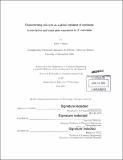Characterizing cell-cycle as a global regulator of stochastic transcription and noisy gene expression in S. cerevisiae
Author(s)
Quinn, Katie J. (Katie Julia)
DownloadFull printable version (17.23Mb)
Other Contributors
Massachusetts Institute of Technology. Department of Chemical Engineering.
Advisor
Narendra Maheshri.
Terms of use
Metadata
Show full item recordAbstract
Even in the same environment, genetically identical cells can exhibit remarkable variability, or noise, in gene expression. This expression noise impacts the function of gene regulatory networks, depending on its origins. Hence, a prerequisite for understanding or designing gene regulatory networks is characterizing the origins and statistics of the noise. Variability has been largely attributed to the inherently stochastic nature of transcription. Expression statistics from multiple organisms are consistent with an influential model of "bursty" expression, where promoters are generally inactive but infrequently produce multiple mRNA. But fluctuations in the cell environment can also contribute, leaving the origins of noise unclear. We sought to determine the origins of noise in gene expression from the synthetic tetO promoter in S cerevisiae. We use single-molecule mRNA FISH to quantify nuclear and cytoplasmic mRNA in a population expression distribution, and models of stochastic mRNA production and degradation to infer underlying transcriptional dynamics. Rather than transcriptional bursting, we find that noise is driven by large differences in transcriptional activity between the G1 and S/G2/M stage of the cell cycle. Furthermore, we quantitatively characterize these dynamics of transcription by measuring expression in cells arrested at the G1/S and G2/M transition. Promoters activate in S/G2 with probability determined by activator level. mRNA statistics from an active promoter with a single operator are Poisson; expression with multiple operators is more variable. Promoters appear to inactivate at the M/G1 transition, with lower activator levels leading to increased probability of inactivation. Thus below a certain activator threshold, all cells are inactive in G1.mRNA processing and export introduces further variability. Similar analysis of the native, chromatin-regulated PHO5 promoter yields the same results. Hence cell-cycle driven transcription dynamics may be prevalent among regulated yeast genes. The timing of S/G2 activation suggests DNA replication and chromatin maturation may be linked to repressed transcription. Cell-cycle-linked fluctuations in expression are likely to affect gene behavior in regulatory networks. This thesis advocates the importance of cellular context in gene regulation and reveals a novel role of cell-cycle as a driver of eukaryotic transcription, advancing our understanding of stochastic transcription and noise in gene expression.
Description
Thesis: Ph. D., Massachusetts Institute of Technology, Department of Chemical Engineering, 2014. Cataloged from PDF version of thesis. Includes bibliographical references.
Date issued
2014Department
Massachusetts Institute of Technology. Department of Chemical EngineeringPublisher
Massachusetts Institute of Technology
Keywords
Chemical Engineering.